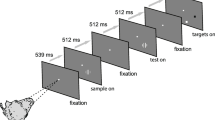Abstract
Space constancy (the perception that the world remains stable despite eye movements) might be mediated by receptive fields with constant locations in the world rather than constant locations on the retina. In a strong form the hypothesis, receptive fields of single neurons would compensate for all eye movements, whereas in a weak form they would compensate only for the small movements of fixation that occur without retargeting. Early receptive field mapping confounded world-centered and retina-centered organizations by fixing the retina relative to the world. This paper links the strong and weak forms of constancy by relating previously isolated data, and illustrates the issues with a previously unpublished figure showing that striate receptive field have constant retinal locations. The first tests of space constancy in striate cortex contradicted the strong hypothesis; recent tests contradict the weak hypothesis, also. The results are consistent with modern theories of space constancy, differentiating between motor-oriented and perceptual functions of vision, and differentiating between constancy during pursuit and constancy across saccades.
Similar content being viewed by others
Author information
Authors and Affiliations
Additional information
Received: 5 January 1998 / Accepted: 16 July 1998
Rights and permissions
About this article
Cite this article
Bridgeman, B. Neither strong nor weak space constancy is coded in striate cortex. Psychological Research Psychologische Forschung 62, 261–265 (1999). https://doi.org/10.1007/s004260050055
Issue Date:
DOI: https://doi.org/10.1007/s004260050055




